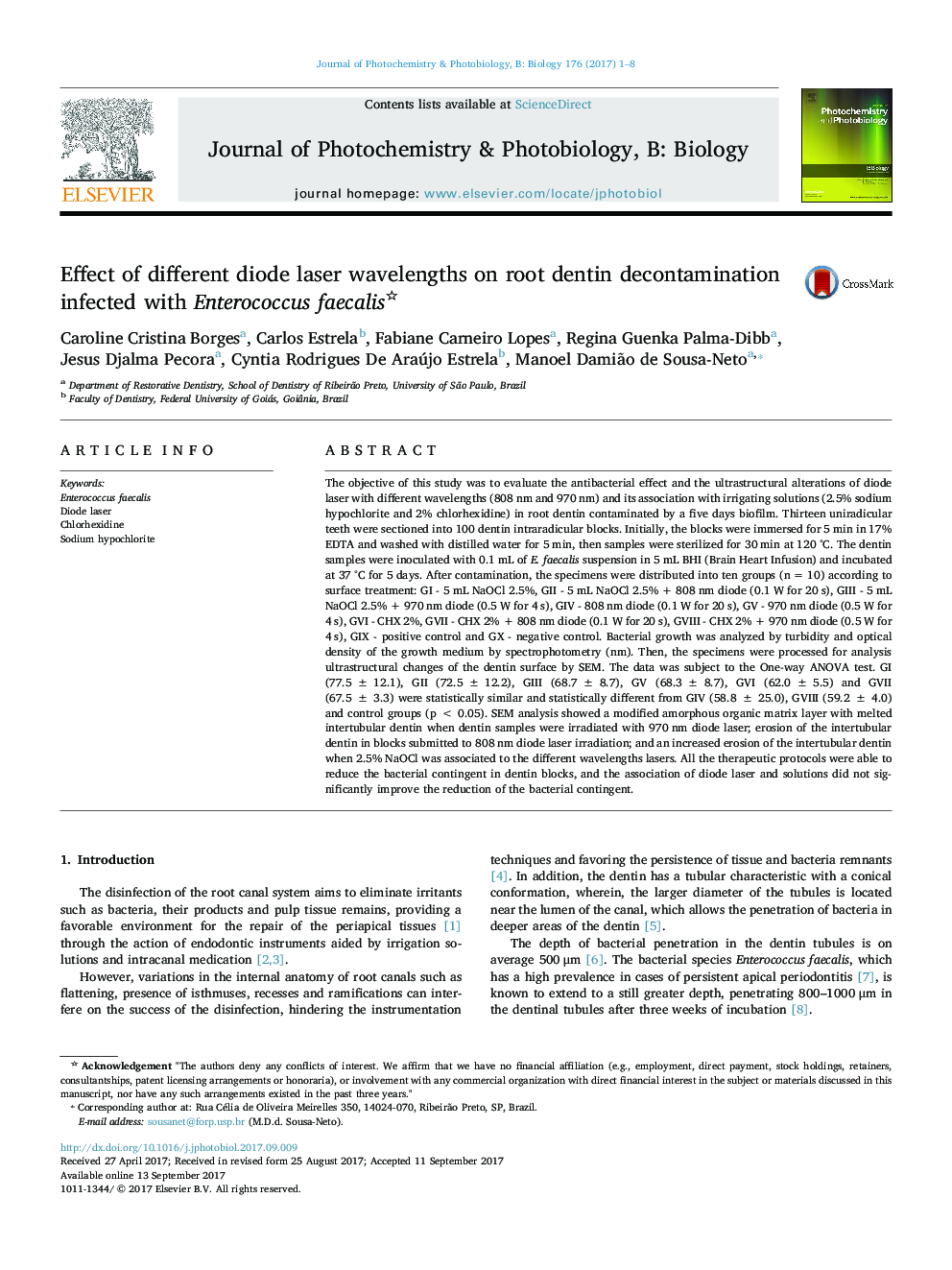| کد مقاله | کد نشریه | سال انتشار | مقاله انگلیسی | نسخه تمام متن |
|---|---|---|---|---|
| 4754289 | 1418057 | 2017 | 8 صفحه PDF | دانلود رایگان |
عنوان انگلیسی مقاله ISI
Effect of different diode laser wavelengths on root dentin decontamination infected with Enterococcus faecalis
دانلود مقاله + سفارش ترجمه
دانلود مقاله ISI انگلیسی
رایگان برای ایرانیان
کلمات کلیدی
موضوعات مرتبط
مهندسی و علوم پایه
مهندسی شیمی
بیو مهندسی (مهندسی زیستی)
پیش نمایش صفحه اول مقاله

چکیده انگلیسی
The objective of this study was to evaluate the antibacterial effect and the ultrastructural alterations of diode laser with different wavelengths (808 nm and 970 nm) and its association with irrigating solutions (2.5% sodium hypochlorite and 2% chlorhexidine) in root dentin contaminated by a five days biofilm. Thirteen uniradicular teeth were sectioned into 100 dentin intraradicular blocks. Initially, the blocks were immersed for 5 min in 17% EDTA and washed with distilled water for 5 min, then samples were sterilized for 30 min at 120 °C. The dentin samples were inoculated with 0.1 mL of E. faecalis suspension in 5 mL BHI (Brain Heart Infusion) and incubated at 37 °C for 5 days. After contamination, the specimens were distributed into ten groups (n = 10) according to surface treatment: GI - 5 mL NaOCl 2.5%, GII - 5 mL NaOCl 2.5% + 808 nm diode (0.1 W for 20 s), GIII - 5 mL NaOCl 2.5% + 970 nm diode (0.5 W for 4 s), GIV - 808 nm diode (0.1 W for 20 s), GV - 970 nm diode (0.5 W for 4 s), GVI - CHX 2%, GVII - CHX 2% + 808 nm diode (0.1 W for 20 s), GVIII - CHX 2% + 970 nm diode (0.5 W for 4 s), GIX - positive control and GX - negative control. Bacterial growth was analyzed by turbidity and optical density of the growth medium by spectrophotometry (nm). Then, the specimens were processed for analysis ultrastructural changes of the dentin surface by SEM. The data was subject to the One-way ANOVA test. GI (77.5 ± 12.1), GII (72.5 ± 12.2), GIII (68.7 ± 8.7), GV (68.3 ± 8.7), GVI (62.0 ± 5.5) and GVII (67.5 ± 3.3) were statistically similar and statistically different from GIV (58.8 ± 25.0), GVIII (59.2 ± 4.0) and control groups (p < 0.05). SEM analysis showed a modified amorphous organic matrix layer with melted intertubular dentin when dentin samples were irradiated with 970 nm diode laser; erosion of the intertubular dentin in blocks submitted to 808 nm diode laser irradiation; and an increased erosion of the intertubular dentin when 2.5% NaOCl was associated to the different wavelengths lasers. All the therapeutic protocols were able to reduce the bacterial contingent in dentin blocks, and the association of diode laser and solutions did not significantly improve the reduction of the bacterial contingent.
ناشر
Database: Elsevier - ScienceDirect (ساینس دایرکت)
Journal: Journal of Photochemistry and Photobiology B: Biology - Volume 176, November 2017, Pages 1-8
Journal: Journal of Photochemistry and Photobiology B: Biology - Volume 176, November 2017, Pages 1-8
نویسندگان
Caroline Cristina Borges, Carlos Estrela, Fabiane Carneiro Lopes, Regina Guenka Palma-Dibb, Jesus Djalma Pecora, Cyntia Rodrigues De Araújo Estrela, Manoel Damião de Sousa-Neto,